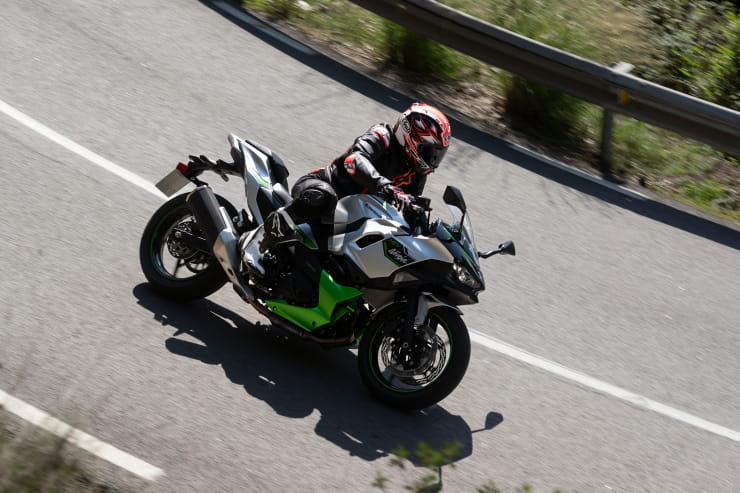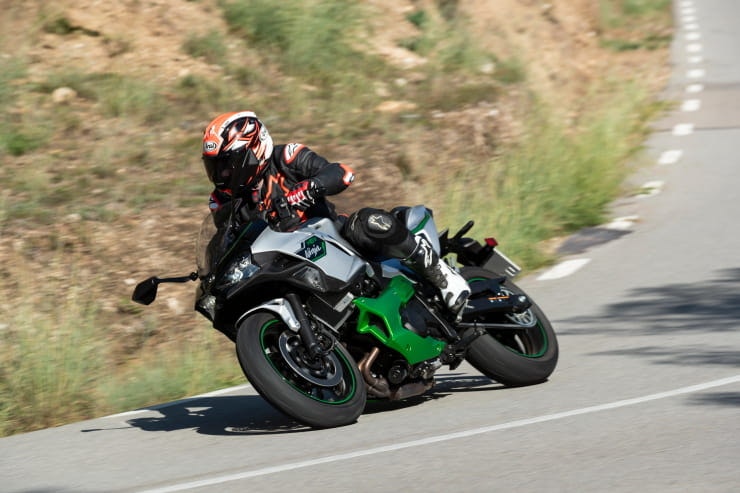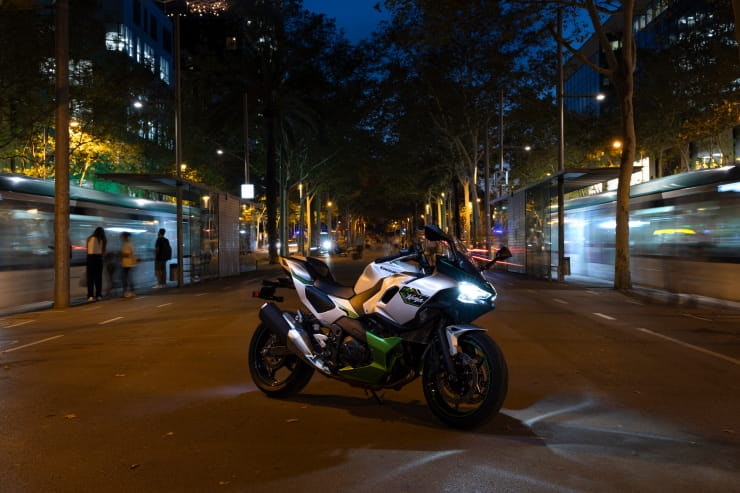Kawasaki Ninja 7 HEV Hybrid (2024) - Review
By Alan Dowds
Has been writing about bikes for more than twenty years
17.10.2023
Technical Review - Ben Purvis
Riding review - Alan Dowds
Price: £11,949 | Power: 58.3bhp, 68.5hp with ‘e-boost’ | Weight: 227kg wet | Overall BikeSocial Rating: 4 / 5
It’s been two years since Kawasaki first previewed its planned hybrid petrol-electric sports bike in October 2021 but it’s finally been launched – and will be in UK dealers for all to buy by April 2024.
We rode it in Barcelona, Spain, last week (Oct '23), over a day and half of all types of road. And it’s fair to say that the new technology has been implemented in a really useful, practical way, that balances performance, economy and usability in an intelligent fashion.
Part of a plan to electrify its entire motorcycle range by 2035, meaning all new Kawasaki’s will be either pure electric or hybrid, and to introduce 10 such machines by 2035, the Ninja 7 Hybrid is by far the most advanced petrol-electric model two-wheeler ever to reach production. Combining a 451cc parallel twin with an electric motor, plus an automated manual transmission, the Ninja 7 Hybrid offers off-the-line acceleration comparable to a 1000cc superbike, outright performance in the 650cc-700cc class and fuel economy that’s even better than the firm’s own Ninja 250.
Quick off the line, with very usable performance
If you’re into tech, the Ninja 7 Hybrid has it in spades, and it works well
“E-boost” feature adds a fun element to worthy hybrid thinking
Great range and fuel economy
The extra tech adds mass of course: it weighs in at 227kg wet
It costs around £12k
Slightly fussy styling
Kawasaki Ninja 7 HEV Hybrid
"The world's first* strong hybrid* motorcycle offers riders a number of new riding experiences: a mid-size package with the instant acceleration of a 1,000cc-class supersport model from a standing start (with e-boost), fuel economy on par with the 250cc-class, and button-shift sport riding."
Review – In Detail
Price & PCP
For and against
Engine & Performance
Handling & Suspension (inc. weight & brakes)
Comfort & Economy
Equipment
Rivals
Verdict
2024 Kawasaki Ninja 7 HEV Hybrid Price
Well, we were close when we reviewed the bike back in October and guesses at c.£12k when in actual fact, the price (revealed 8th Feb 2024) is confirmed as £11,949, and it'll be available in dealerships from April. Is that good value? Well, it’s hard to say: on one hand, it’s a technology showpiece, with innovations unseen elsewhere. Name another sports bike with an electronic transmission that can be operated in either manual or auto mode, even offering a reverse function, and features an ‘e-boost’ button to give an kick of extra power and torque when you call for it.
On the other, the outright power is on a par with the Ninja 650, a bike that also donates its modest forks and brakes, and the rear suspension is akin to the Ninja 400, suggesting Kawasaki is keeping a careful cap on costs to make sure the Ninja 7 Hybrid is within reach.
Having ridden it, we reckon the price is a fair deal at the moment. Early adopters are used to paying a bit extra for the latest kit, and the Ninja 7 is a well-thought-out, properly engineered piece of kit. You’ll save a little bit of cash on petrol costs, sure – but the Ninja 7 justifies its price by its green credentials and cutting-edge tech, rather than because of an extra 20mpg on a run.
2024 Kawasaki Ninja 7 HEV Hybrid Engine & Performance
At the heart of the Ninja 7 Hybrid lies a 451cc parallel twin that Kawasaki describes as ‘brand new’ – although that capacity is shared with the Eliminator EL500 and it’s been clear ever since the earliest prototypes of the hybrid were shown that the engine is closely related to the twin in the Ninja 400 and Z400 (and which also forms the basis of the EL500’s 451cc twin). There are a lot of differences, but the new engine does share the Eliminator’s 70mm bore and 58.6mm stroke.
However, the petrol engine’s power ooutput is substantially higher than the Eliminator or Z400, which are both A2-legal machines with sub-47hp outputs. On petrol power alone, the Ninja 7 Hybrid manages 58.3hp (43.5kW), rising to 68.5hp (51.1kW) when the ‘e-boost’ function is engaged, adding the electric motor’s power to the mix. The electric motor seems to allow a revvier tune to the combustion engine, with more peak power output and less low-down torque – because the battery powered side of the powertrain can fill in the missing grunt.
Off the line, Kawasaki says the performance, with e-boost, is on a par with a 1000cc superbike, thanks to the immediate extra torque of the electric motor. Overall, the firm puts the performance in the same league as 650cc-700cc bikes.
That 9kW/12bhp peak power electric motor is located behind the cylinders and above the gearbox, and is the same as the one used in the new Ninja e-1 and Z e-1 electric bikes, though it has a water-cooling circuit here, with its own small radiator in front of the main radiator, rather than the air-cooling on the smaller e-1 bikes. The motor is powered by a 48V lithium-ion battery under the seat and the physical drive is transferred by a chain that runs behind the main clutch. That directly drives the gearbox input shaft, so the electric motor can always direct torque to the rear tyre. Meanwhile, having the main computer-controlled clutch ‘upstream’ of the motor drive lets the bike disconnect and turn off the petrol engine at a halt when in Eco mode, and permanently when in EV battery-only mode.
In the all-electric mode, performance is understandably limited, with Kawasaki suggesting it’s intended for residential areas or parking garages. We tested it fully around Barcelona, though, and it was actually much more useful than we expected. It will hit nearly 40mph, gets there quite quickly, and easily did about 4-5 miles around the city, with plenty of charge still left in the battery (the bike will automatically switch out of EV mode when the battery is depleted).
The ‘e-boost’ function, which we first revealed way back in 2020 thanks to Kawasaki’s own patent on the idea, maxes out the electric power boost to briefly combine all the power and torque of both the electric and petrol powertrains. It only works in Sport mode, and operates for just five seconds, but it regenerates just as quickly, and is a usable way to add an extra dollop of instant grunt to the output.
The combined powertrain drives through a manual transmission, but because it needs to be able to juggle power automatically and seamlessly from the electric motor and combustion engine, it’s an electronically-operated one with an automatic clutch and solenoid gear actuator. That means there’s no clutch lever on the left bar or gear lever by the left peg. Shifts can be done either fully-automatically or via bar-mounted buttons in manual mode.
The Ninja 7 isn’t a plug-in hybrid, so you can’t charge the battery separately – it’s only charged when the bike is moving. Kawasaki has given the petrol engine an integrated starter/generator unit on the left hand side of the crank, which combines the roles of starter motor and alternator. It regenerates when you’re braking or off the throttle, taking that kinetic energy and converting into electrical energy to charge the battery. Using the power later to assist the petrol engine is what gives the improved economy and stronger drive.
2024 Kawasaki Ninja 7 HEV Hybrid Handling & Suspension (inc. Weight & Brakes)
The frame is a steel trellis design, much like the existing Ninja 650 and Ninja 400 models, but it’s purpose-made for the Ninja 7 Hybrid to be able to pack in the engine, electric motor, fuel tank and battery pack, all in a bike that’s not too big.
It’s fair to say Ninja 7 isn’t a small machine though. The 1,535mm wheelbase is 125mm longer than the Ninja 650’s – down to a longer swingarm design that is designed to improve traction and handling with the extra low-down torque. The wet weight is 227kg – a 34kg increase on the 650, and 59kg more than a Ninja 400. It’s a substantial chunk of mass, but is located low-down on the bike, and on the move, the Ninja 7 doesn’t feel particularly heavy or unbalanced.
The brakes are the same twin axial-mount, two-piston Nissin calipers as used on the Ninja 650, with plain 300mm discs rather than petal discs, and the right-way-up forks are also the same: they’re non-adjustable and 41mm in diameter. The rear suspension, in contrast, is closer to the Ninja 400’s design, with a simple, rectangular-section swingarm and rising-rate monoshock, that’s adjustable for preload only.
2024 Kawasaki Ninja 7 HEV Hybrid Comfort & Economy
With a semi-auto transmission and the ability to run in all-electric mode at low speeds, the Ninja 7 Hybrid’s forte is smooth useability, and despite having the 48V battery under the rider’s seat, the 795mm seat height is around the same as a Ninja 650 (790mm). The seat is a little on the hard side though, and was a bit uncomfortable after a full day and a half in the saddle. But the riding position is easy and relaxed, mirrors work well, and the pegs-bars-seat layout was fine for my 172cm/84kg frame.
Economy is where any hybrid should really shine: the whole point of the battery is to store otherwise wasted energy when the bike slows down, then using it to provide acceleration via the electric motor when needed. And the Ninja is strong here: in Eco mode, the firm says you can expect around 77mpg – a solid performance, and one which will get you nearly 240 miles range out of the 14-litre fuel tank. Sport hybrid isn’t bad either: Kawasaki reckons you’ll get 71mpg in that mode using a European WMTC test protocol.
2024 Kawasaki Ninja 7 HEV Hybrid Equipment
Early-adopters are likely to be a key demographic among Ninja 7 Hybrid buyers so Kawasaki has given the bike plenty of advanced features.
As well as the three riding modes and the ability to run in pure EV form when required, the addition of an electric motor means Kawasaki has been able to give the Hybrid a ‘walk mode’ that trundles the bike forwards or backwards at low speed to help when you’re manoeuvring into tight spaces or shifting it around your garage.
There’s a full colour TFT dash and smartphone connectivity, of course – these things are becoming the norm in the 2020s – but the hybrid design and auto box means Kawasaki has also been able to add some less familiar tech. One example is the Automatic Launch Position Finder (ALPF) that, when activated, automatically selects first gear whenever you come to a halt.
It could do with cruise control, especially when you’re relaxing in the Eco automatic gearbox mode. According to the launch engineers, that would be simple enough to accommodate, so expect any second-generation hybrid machine to incorporate that as an easy upgrade. In addition, there’s no traction control of any kind, and the ABS is a simple non-cornering system: again, we’d expect to see those upgrades in future machines.
2024 Kawasaki Ninja 7 HEV Hybrid Rivals
It’s almost impossible to pick any rivals for the Kawasaki Ninja 7 – there’s really nothing like it out there.
If you want to be among the first to experience a proper hybrid-powered sports bike, this is your only option.
2024 Kawasaki Ninja 7 HEV Hybrid Verdict
We spent a full day and a half on the Ninja 7 around Barcelona, and it’s fair to say that we were really impressed. When a firm says something like ‘you get three bikes in one’, we turn on our BS detectors and get ready to repel nonsense. But this time, they’ve got it right. In its battery-only EV mode, the Ninja 7 is like an easy, electric urban scooter, with a 40mph top speed and 5-10 miles of range. It’s silent and cool (Barcelona was very hot and no petrol engine running underneath my backside was a boon), while the automatic clutch and gearbox means an easy twist-and-go performance.
Moving on a level, the Eco hybrid mode is a commuter’s dream. Automatic gears, with a manual override if you want, and the petrol engine kicking in with full performance when needed means you have a relaxed, civilised, simple ride. When you come to a halt at lights or a junction, the petrol side turns off, so you sit in serene peace, again with no heat belting out from the radiator. Then, with a quick twist of the throttle, the electric motor starts you off like a MotoGP technician pushing you down pit lane. The petrol engine kicks in once you’re moving, and it’s all very smooth and refined – plus you get that sweet sweet 77mpg fuel consumption.
Last up is the Sport hybrid mode, and this really does offer a different side to the Ninja 7. It’s manual-only on the transmission, so you need to click up and down the gearbox using the paddle switched on the left-hand bars. The automatic clutch and gearchange works with the usual blipping functions via the ride-by-wire throttle, so the little 451cc motor blatts away under you as you change down into a bend, hard on the brakes. The performance is brisk rather than fast: 227kg and 69bhp isn’t going to set anyone’s pants on fire in 2023, but the low-down nature of the electric grunt assistance makes up for that a bit. Off the line, Kawasaki says you’ll be able to keep ahead of a ZX-10R for 50 metres or so – but on the road, the comparison with a Ninja 650 is much more on the money.
Once question that does arise is why did Kawasaki use a sportsbike as the foundation for the first hybrid bike. From my 36 hours on the Ninja 7, I reckon a Versys 7 Hybrid would have been just as good, perhaps even better, as a demo of the tech. It would probably have sold in higher numbers too. When I put that to the very nice Japanese engineers, they just laughed and said they preferred sportsbikes, so that was what they made. Fair play…
Away from the unique powertrain, the rest of the bike is perfectly adequate as a gentle sporty roadster. The suspension is on the soft side, and the brakes are slightly squidgy, but both are up to some moderately angry blasting up a mountain road near Barcelona. At the end of the day though, none of that is really the point. Kawasaki has had a very good first go at making a hybrid motorbike, which cleverly integrates a traditional petrol engine and a battery-powered electric motor, giving the best of both, and minimising the downsides of either.
If you’d like to chat about this article or anything else biking related, join us and thousands of other riders at the Bennetts BikeSocial Facebook page.
2024 Kawasaki Ninja 7 HEV Hybrid - Technical Specification
Looking for motorcycle insurance? Get a quote for this motorbike with Bennetts bike insurance
What is MCIA Secured?
MCIA Secured gives bike buyers the chance to see just how much work a manufacturer has put into making their new investment as resistant to theft as possible.
As we all know, the more security you use, the less chance there is of your bike being stolen. In fact, based on research by Bennetts, using a disc lock makes your machine three times less likely to be stolen, while heavy duty kit can make it less likely to be stolen than a car. For reviews of the best security products, click here.
MCIA Secured gives motorcycles a rating out of five stars (three stars for bikes of 125cc or less), based on the following being fitted to a new bike as standard:
A steering lock that meets the UNECE 62 standard
An ignition immobiliser system
A vehicle marking system
An alarm system
A vehicle tracking system with subscription
The higher the star rating, the better the security, so always ask your dealer what rating your bike has and compare it to other machines on your shortlist.


